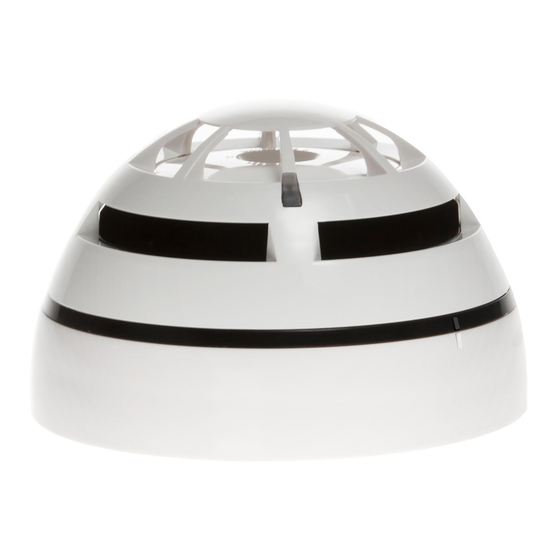
Advertisement
Quick Links
BI-DIRECTIONAL WIRELESS ADDRESSABLE CLASS P HEAT
OVERVIEW
This detector model samples the environmental temperature in the protected area. An alarm condition is raised when the level of temperature
or the thermal variation rate exceeds the alarm threshold.
COMPATIBILITY
This detector is compatible only with wireless systems based on the Sagittarius protocol.
For more specific information concerning compatibility refer to your fire security system supplier.
INSTALLATION - IMPORTANT NOTES
For detector spacing, placement and special applications refer to your specific national standards.
Mount the detector as far as possible from metal objects, metal doors, metal window openings, etc. as well as cable conductors, cables
(especially from computers), otherwise the operating distance may greatly drop. The detector must NOT be installed near electronic devices
and computer equipment that can interfere with its wireless link quality.
This detector must be installed according precisely to the procedures
described in this manual.
Test this detector after installation.
BEFORE INSTALLING THE DETECTOR
1) Extract the batteries cover from the back of the detector.
2) Power-up the detector removing the isolating tab in the battery
housing. LED indicators signal "Power up".
3) Link the detector to the Sagittarius wireless system (LINKING).
4) Check the WIRELESS LINK QUALITY.
5) SELECT A GOOD LOCATION FOR THE DETECTOR.
6) Tag device's loop and address data (IDENTIFICATION).
7) Fix the detector supporting base to the wall (BASE INSTALLATION).
LED INDICATORS
Picture 1: provides visual indication for functional conditions and battery levels as indicated in table 1.
Detector's status
LEDs indication
Power up
1 second GREEN, then 4 X 0.5 second RED blink
Linking to the system
Blinking GREEN until linking is completed
Link failure
RED on (continuous)
Normal condition
LEDs off
Alarm
Blinking RED: 0.5 second on and 0.5 second off
0.1 second ORANGE blink, then 5 seconds off
Battery 1 fault
Battery 2 fault
0.1 second GREEN blink, then 5 seconds off
0.1 second ORANGE, then 5 seconds off
Both batteries fault
0.1 second GREEN, then 5 seconds off
Other fault
sequential ORANGE / GREEN 0.5 second blinking
Tamper
LEDs off
Lost link with wire to
wireless translator /
LEDs off
wireless expander
ARGUS SECURITY S.R.L. - Via del Canneto, 14 - 34015 - Muggia (TS) - Italy
L-HT-SG
DETECTOR
Picture 1
LED INDICATORS
Table 1
LINKING
The system is waiting to achieve a wireless child device (for further information
refer to the translator's or the Wirelex configuration software's literature):
1) Move the link switch's cursor from ON to the opposite side of its run (we will
928j/02
call it BLANK, since it carries no indication). LED indicators signal "Linking to the
system" (picture 2).
Linking is successful when:
a) the translator indicates so (check translator's literature)
b) the Wirelex software indicates so (check the Wirelex's literature).
If linking is unsuccessful:
2) Check if evident mistakes were made.
3) Perform the LINKING RECOVERY.
LINKING RECOVERY
1) Take out both batteries from their holders
2) Move alternatively the link switch to ON / BLANK five times (picture 2)
3) Move the link switch to ON
4) Reinsert both batteries into their holders, oriented as per polarity marks
5) Perform the LINKING procedure
DETECTOR SENSITIVITY SETTINGS
During installation using the Wirelex software it's possible to set the heat class of the detector (see table 4).
Otherwise if the installation is performed manually through the translator keyboard, default setting will be applied.
WIRELESS LINK QUALITY
It is possible to check wireless link quality between the detector and its linked-to translator or expander in this way:
1) Move the link switch to the ON position.
2) LED indicators will start blinking according to the following table:
Communication quality
No communication
Communication quality: 0 dB - 10 dB (Mark 2)
Communication quality: 10 dB - 20 dB (Mark 3)
Communication quality: 20 dB - 30 dB (Mark 4)
Communication quality: > 30 dB (Mark 5)
3) NOTE: Ensure the link switch is returned to the "BLANK" (operational) position on completion of testing.
SELECT A GOOD LOCATION FOR THE DETECTOR
Choose for the detector a placement position that:
- compliances with your specific standards
- is reached by a strong wireless signal from its linked-to
translator or expander module
- is not interfered by environmental factors.
IDENTIFICATION
For identification purposes, analogue loop number and device's
address can be recorded on the plastic tag supplied with the
base (picture 3).
Extract the plastic tag from the bottom of the base, write or label
identification data on it and, finally, insert it in the side slot of the
base.
www.argussecurity.it
info@argussecurity.it
Link switch
OR
Assessment
Fail
Poor, not acceptable
Medium-low, not recommended
Good
Excellent
Picture 2
During the linking phase, the
detector
must
be
positioned
close to the aerial (within a few
centimeters) of the translator or
expander to which it is being linked.
Device's indication
Two red blinks
One red blink
One green blink
Two green blinks
Two green blinks
Table 2
Picture 3
L20-LHTXX-0001 (vA.6)
AB
Advertisement

Summary of Contents for Argus Security L-HT-SG
- Page 1 Picture 3 Table 1 ARGUS SECURITY S.R.L. - Via del Canneto, 14 - 34015 - Muggia (TS) - Italy www.argussecurity.it info@argussecurity.it L20-LHTXX-0001 (vA.6)
- Page 2 3) If it works LED indicator will signal “Alarm”. NOTE OF THE DOCUMENT: Argus Security Srl hereby declares that this detector is in compliance with the essential requirements and other relevant provisions of TEST 2 - HEAT TEST Directive 1999/5/EC. A copy of the original Declaration of Conformity (Document: DoC LI01) is made available to the user on website: www.argussecurity.it...













Need help?
Do you have a question about the L-HT-SG and is the answer not in the manual?
Questions and answers